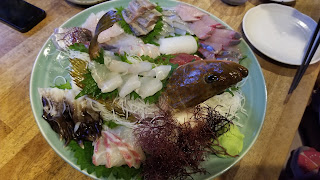 |
Kappa, a water spirit on the steps of
an old Samurai home in Chiran |
Another day, another hike—a very comfortable rhythm, yet every day and every hike is different. And so are our culinary experiences. We’ve left the ancient Buddhist trails portion of our trip and have been exploring the volcanoes and beauty of the rest of Kyushu Island.
 |
Kyushu, Japans, largest southern island.
We started at the top, and now we're
south of Kagoshima, near the bottom |
Five days ago we enjoyed the luxury of spending two nights in the same place at the hot springs resort area at the base of Mt. Yufuin. The climb to the top of it was well worth the seven hours it took to ascend 800 meters and descend 1200 back to town. We lucked out with perfect weather.
 |
| Mt. Yufuin in the distance |
 |
| View from near the top of Mt. Yufuin |
We only had one really long bus day, coupled with a train ride. It took us down to the bottom of one of the world’s largest calderas at Aso, (12 miles across and 18 long), complete with rice paddies, two cities, and multi-story apartments.
 |
| The giant caldera at Aso |
Then we ascended 500 meters to the rim on the other side for a hike among the azaleas to the top of Mt. Eboshi to view the active Mt.Naka volcano. The azaleas were spectacular!
 |
| View the way to Mt. Eboshi |
After a bullet train ride we spent the night in Kagoshima, the third largest city on Kyushu Island.
We woke up the next morning to find the city streets dusted with gritty volcanic ash from an overnight eruption of Mt. Sakurajima 20 miles away.
 |
| Mt. Naka blowing off steam |
One of our regrets about this trip is that we just couldn't work the Hiroshima Peace Park into our itinerary. However, we may have made up for it in a small way with a visit the next morning to the Peace Museum for the Kamikaze pilots, located in Chiran, the site of a former Japanese Air Force base. Kamikaze means "divine wind," from over 1,000 years ago when typhoons wiped out two invading Chinese navies. It was both fascinating and highly emotional. We saw the artifacts and photos of all 937 pilots, including some translations of their poignant last letters to their parents, wives, girlfriends, and children.
 |
| The Kamikaze Peace Museum |
Many of the pilots were only 17 and had never seen combat before, but they had been training since the age of 14. No one, including their commanders, suspected months earlier that they would be flying such desperate last-ditch missions in the battle of Okinawa. Many didn’t want to go and were scared, but their honor and duty were more important then their own lives. I wonder if soldiers and airmen of the Allied forces felt the same way on the eve of Normandy, bombing missions over Germany, the invasion of Iwo Jima. Perhaps, but they at least had a glimmer of hope that they might survive. The Kamikaze pilots didn’t. Only 10-15% hit their targets, but nearly all of them died.
 |
| At a Samurai garden near Chiran |
Nearby we visited a well-preserved Samurai village dating back to the the 1600s. This was the "Edo Period" of peace that lasted for about 250 years. The Samurai got bored of all that peace stuff and focused on gardens and geishas. The Kappa water spirit at the top of the post was on one of the steps to a home.
We ended the day with a climb part way up Mt. Kaimon, the “Mt. Fuji of the South.” This was the last glimpse the pilots saw of the Japan mainland as they tipped their wings and headed and headed toward Okinawa. The hike was hot and humid in lush foliage and volcanic rock.
 |
| Mt. Kaimon, the "Mt. Fuji of Satsuma" |
 |
| View from part way up Mt. Kamian |
We ended the day in a resort town with hot mineral baths. Our inn had several of varying temperatures, including ice-cold. Nice!
Click here for more photos.
 |
| Getting ready to "sabo-sabo" pork in Kagoshima |
 |
| The mother of all sashimi in Yufin |
 |
Mario, our guide and
tabletop barbecue expert |














No comments:
Post a Comment